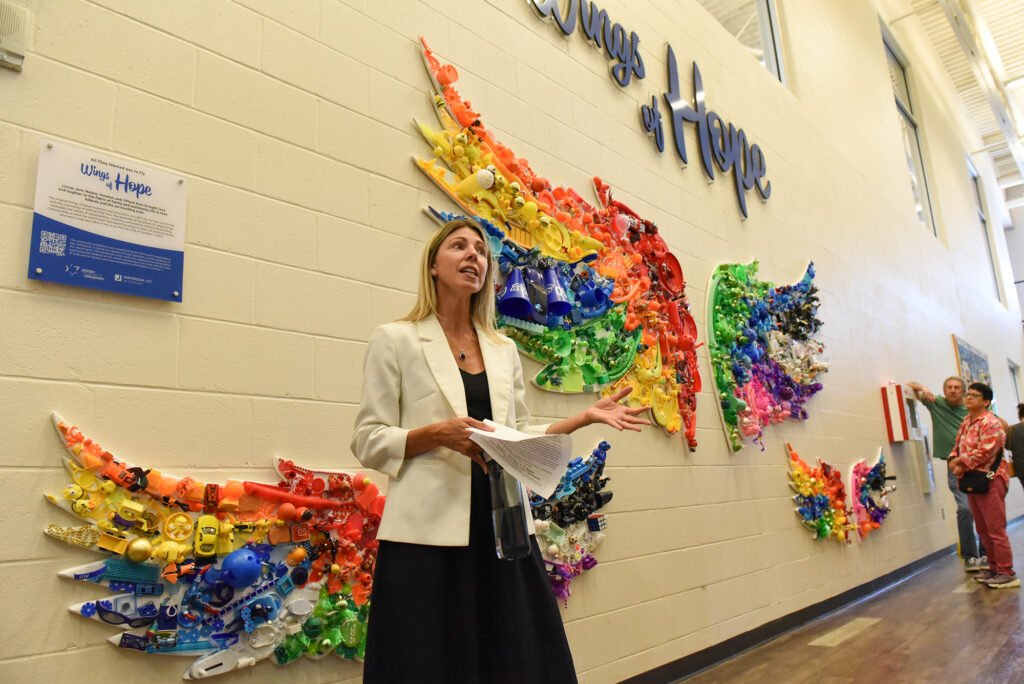The Wings of Hope

CINCINNATI — October 5th was a perfect Sunday morning in Cincinnati. The air was crisp, sunlight filtered through the trees, and three police cars stood outside the Mayerson JCC as people filed in, IDs in hand. Outside, a giant Israeli flag caught the wind. There was no ambiguity about where this building stood.
The scene felt ordinary and extraordinary at once. Inside, the crowd gathered to mourn the victims of October 7th, to wrap soft dolls for children in memory of a girl named Noya, and to remember the spirit of Livnat Kutz. Beneath the ceremony ran another countdown: the deadline for Hamas to release hostages. Even from halfway around the world, that clock ticked in every heart.
The Amberley Room filled slowly: a rabbi with his children, Israelis, Americans, even a Holocaust survivor. Amid the murmured greetings of neighbors, Rabbi Sammy Kanter stepped to the microphone to make meaning out of the unbearable.
He told a story that wasn’t really his alone. On the morning of October 7th, he had been leading services in New York. One prayer at a time, the world shifted. He described the helplessness of learning about a massacre while standing on the bimah, then invited everyone in the room to go back to that moment—not to relive it, but to name it together.
Names were read and stories retold: the ones who didn’t come home, the ones who did but were never really whole again. Then came another list — the names of the living who are still not free. The hostages. Their names landed in the room like heartbeats.
Next, Tzach Shmuely stepped to the microphone to tell the story of Noya, a 12-year-old girl who loved art and Harry Potter and kissed each doll in her collection goodnight. In her honor, volunteers packed toys for foster children in Cincinnati.
Children and teens packed bags of toys for kids in foster care, doing small things to make the gifts feel special—writing cards, sorting donations, and adding playful touches like tiny hats on stuffed bears to make them feel like gifts, not donations.
Finally, JCC CEO Holly Wolfson took the stage to talk about Livnat Kutz, a mother and artist from Kfar Aza. She invited everyone downstairs to unveil Wings of Hope, a 10-foot mosaic made from broken toys, dolls and LEGO pieces. Remnants turned radiant. Beauty refusing to die.
Educator Idit Moss described visiting Kfar Aza after Oct. 7. She saw Livnat’s mural there, Wings of Hope, a symbol of unity and peace painted before the massacre. “We need that in Cincinnati,” she told her colleagues. Now, she said, “Livnat’s spirit and her mission are here. They believed in peace.”
Nearby, a student artist squinted at the finished piece through binoculars. “It looks very big,” he said, smiling.
Rabbi Kanter spoke again about why the project mattered. “We wanted to give our community a time to mourn and have a kernel of hope that’s living on our wall,” he said. “By seeing broken toys that you might think are garbage transformed into a beautiful sign of hope and peace, it reminds us that even with all the grief and mourning and despair we’re still feeling as a Jewish community, we will find hope one day.”
As participants began to leave, Idit spoke quietly about the hostages. She said she prays they all come home, that the war will end, that peace will begin there. But she also spoke her fear aloud — that maybe it won’t happen soon enough.
And still, she stood beneath those wings. Under them, the room felt lighter. Livnat Kutz could never have imagined how her art would take flight across the world. Here in Cincinnati, her vision has been rebuilt from broken toys into a permanent message of hope. People filed out with hard questions still hanging — about the hostages, about safety, about what comes next — but the wings stayed put, a memory of Livnat, a woman who dared to hope.